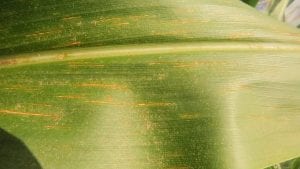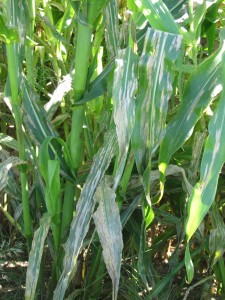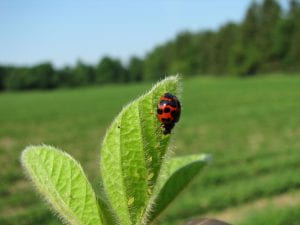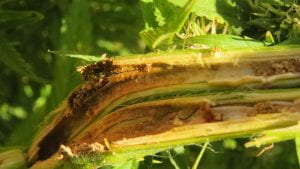Volume 18 Number 20
Contents
View from the Field
Regional Reports
Mike Stanyard (CCE Northwest Dairy and Field Crops Team) reports late season soybean aphid populations are still on soybeans. He also points out there are many lady beetles still no the plants feeding on the aphids. In most years, this predation helps keep populations under economic threshold.
Soybean Aphids
Jeff Miller (CCE Oneida County) reports low to moderate levels of northern corn leaf blight and northern Corn Leaf Spot in field corn.
Aaron Gabriel (CCE Capital District) reports moderate leaves of soybean aphids and many lady beetles feeding on the aphids.
Josh Putman (CCE Southwest Dairy and Field Crops Team) reports a LOT of marestail and lambsquarters left unmanaged in soybean fields that have set seed may and be problematic next year.
Jaime Cummings (NYS IPM) is still having several questions on hemp pest and disease-related issues. There are mostly vascular wilts and leaf spots. Jaime states that soybean frogeye leaf spot seems to be increasing in NY (see article below). There is also plenty of soybean Septoria brown spot in most fields as the plants are starting to senesce. She is also seeing low levels of soybean aphids.
Ken Wise (NYS IPM) reports low to moderate levels of northern corn leaf blight, gray leaf spot, and northern corn leaf spot. Ken also reports an infestation of European corn borer in hemp in Dutchess County.
Weather Outlook – September 21, 2017
Jessica Spaccio
NOAA Northeast Regional Climate Center, Cornell University
Last week temperatures ranged from near normal to 8 degrees above normal. Precipitation has ranged from a trace to 2 inches. Base 50 growing degree-days ranged from 30 to 110.
Today a cold front will bring showers with temperatures in the mid 60s to low 70s. Overnight lows will be in 40s to low 50s.
Friday temperatures will be in the mid 60s to mid 70s with mostly sunny skies. Overnight temperatures will range from the upper 40s to low 60s.
Saturday temperatures will range from the 70s to near 80 with showers and thunderstorms possible. A few storms could produce strong, gusty winds and
heavy downpours. Overnight temperatures will be in the low to mid 50s.
Sunday highs will be in the mid 60s to mid70s with sunny skies. Overnight temperatures will be in the 40s.
Monday temperatures will be in the low to mid 70s with scattered showers possible. Overnight temperatures will be in the 50s.
Tuesday highs will be in the 70s (near 80 possible) with scattered showers possible. Overnight temperatures will be in the 50s and low 60s.
Wednesday highs will be in the 70s. Overnight temperatures will be in the 50s.
The seven-day precipitation amounts will range from a trace to near 2 inches.
The 8-14 day outlook (Oct 3-9) favors below-normal temperatures for a majority of the state, excluding far western and southeastern NY. Above-normal precipitation is slightly favored for western to central NY.
Maps of 8-14 day outlooks:
http://www.cpc.ncep.noaa.gov/products/predictions/814day/index.php
National Weather Service watch/warnings map:
US Drought Monitor:
http://droughtmonitor.unl.edu/Home.aspx
CLIMOD2 (NRCC data interface):
http://climodtest.nrcc.cornell.edu
Frogeye Leaf Spot in Soybeans: Becoming More Prevalent in NY?
Jaime Cummings and Ken Wise, NYS IPM
Frogeye leaf spot (FELS) is currently considered a minor foliar disease of soybeans in NY. This easy-to-identify leaf spot is caused by the fungus Cercospora sojina, and typically shows up mid- to late-season in random soybean fields. The disease gets its name from the similarity of the spots to what a frog’s eye looks like, having dark reddish-brown margins and light brown-gray centers (Fig 1). The lesions may be round or irregularly shaped. If you look closely with a hand lens, you may see the spores of the fungus in the center of the spots if it’s humid. These spores in the spots will be wind-dispersed to other leaves, resulting in multiple cycles of the disease in one season if the weather is conducive for infection.
Figure 1. Frogeye leaf spot foliar lesions on soybean leaves in Tompkins County 2019. (Photos by J. Cummings, NYS IPM)
The FELS pathogen has multiple races (up to 20 known races!), which means that management with genetic resistance is race-specific. We do seem to have some highly virulent strains of the fungus in NY, and likely multiple races among those strains. That’s why you can see one soybean field with moderate to high levels of FELS across the road from another soybean field with little to no FELS. The genetic resistance available in some soybean varieties is quite effective, but only against specific races of the pathogen. However, there are soybean varieties available with resistance to all known races of FELS, though maybe not in early maturity groups that are planted in NY.
Figure 2. NY counties with known frogeye leaf spot occurrence 2012-2018 shaded in purple. More counties will be added when updated with 2019 observations. (image courtesy of fieldcrops.org)
FELS has typically been a sporadic pest in NY, rarely reaching epidemic levels that would require fungicide applications (Fig. 2). We’ve been fortunate that when it does appear, it typically shows up during later reproductive stages and will have little to no effect on yield or grain quality. But in recent years, this trend may be changing, and we may need to be more aware of FELS in NY soybean fields, and potentially consider management options.
Figure 3. Severe epidemic of frogeye leaf spot on a susceptible variety. (photo courtesy of T. Allen, Mississippi State University)
I’ve noticed FELS in more and more fields in NY over the past few years, and have had reports of moderate to severe outbreaks earlier in the season in fields planted with susceptible varieties (Fig 3.). FELS is considered one of the major foliar diseases contributing to yield losses in more southern latitudes in the US, causing 17,662,000 bushels lost nationally in 2015; second overall only to Septoria brown spot. Our NY yield losses to FELS have likely been minimal, but that could change as we see more FELS around the state each year. Yield loss from FELS is due to decreased photosynthetic capability of infected leaves and premature defoliation, along with a potential reduction in seed quality. For more information on estimated yield losses to soybean diseases, see this publication by the Crop Protection Network.
Figure 4. Life cycle of frogeye leaf spot fungal pathogen on soybean. (image courtesy of A. Grahek and apsnet.org)
As FELS prevalence increases in NY, so does the local inoculum. The fungus can overwinter on soy residues, including shattered seeds, and can be seed transmitted (Fig. 4). Seed transmission can be mitigated via fungicidal seed treatments and purchasing high-quality, treated seed. Other good integrated pest management practices for reducing FELS in your fields include crop rotation, planting resistant varieties, and potentially foliar fungicide applications in severely infected fields. Should we get to the point where fungicides are needed to manage FELS in NY, there are a number of products available with ‘good’ to ‘very good’ efficacy ratings against this disease. And it is recommended to make protective fungicide applications between R2-R5. See this table from the Cornell Guide to Integrated Field Crop Management for available fungicides. However, it is worth noting that fungicide resistance has been well-document to some quinone outside inhibitor (QoI) group (FRAC group 11) fungicides among numerous FELS fungal populations in at least 13 states (Fig 5). For more information on fungicide resistance in soybean pathogens, visit this site.
Figure 5. Documentation of fungicide resistant populations of frogeye leaf spot pathogen as of 2016. (image courtesy of Plant Management Network)
Making Fall Alfalfa Field Decisions
Ken Wise, NYS IPM
Sometimes we forget that there are IPM practices for the fall in alfalfa. Conducting stand counts is one of these activities. Fall stand counts are an indication of the health of your alfalfa crop. There are a number of pests and crop management issues that can reduce a stand count in alfalfa. The following are guidelines for stand counts in NYS:
| Crowns per square foot | ||
| Harvest Year | Optimum Stand | Adequate Stand |
| New Spring Seeding | 25-40 | 12-20 |
| 1st hay year | 12-20 | 6-10 |
| 2nd hay year | 8-12 | 4-6 |
| 3rd and older | 4-8 | 2-5 |
Note: Number of crowns not stems
The following are photos of alfalfa stand counts from the Cornell Research Farm in Valatie, NY
4 year old field-7 crowns/25 stems per square feet
4 plus years in production-5 crowns/15 stems per square feet
4 year old field-15 crowns/45 stems per square feet
New alfalfa seeding- 20 crowns/70stems per square feet
Note that you may have the recommended crowns per square foot but they may not actually be healthy. Make sure to dig a few plants up to check the roots for signs of disease. You may also want to look at the number of stems per square foot. Here is a guideline for an adequate stand of alfalfa using stem counts.
| Stems/square feet | Action |
Predicted Yield Potential (assuming on winterkill) |
| >55 | Stem density not limiting yield | Same as the current year |
| 40 to 54 | Some yield reduction expected | If in good health the same as the current year. If not could be significantly less. |
| <39 | Consider replacing stand | If in good health the same as the current year. If not could be significantly less. |
Source: University of Wisconsin: http://learningstore.uwex.edu/assets/pdfs/a3620.pdf
Fall scouting before the first hard frost can also reveal pest problems. Finding yellow to brown plants may be an indication of a disease problem such as: verticillium wilt, leaf spots, fusarium wilt, anthracnose and more. An inspection of the root system can also help diagnose disease problems. Yellow, reddish-brown to black discolored or damaged roots may indicate disease problems such as phytophthora root rot or verticillium wilt. In northern NY counties where alfalfa snout beetles (ASB) have been a problem, premature senescence, stunted or yellow alfalfa fields may indicate an ASB infestation. Fields should be evaluated for the presence of the root-feeding larval stage.
Clipboard Checklist
Keith Waldron, NYS IPM
General
*Walk fields to check general field condition, weed, vertebrate and other issues
*Watch for crop maturity, stand assessments, weed escapes, nutrient deficiencies, lodging issues
*Update crop records and field history
Alfalfa:
*Monitor potato leafhopper, foliar, systemic and crown rot diseases, signs of alfalfa snout beetle (in counties where ASB has been confirmed).
*Monitor new seedings for potato leafhopper, pythium blight, phytopthora root rot.
*Evaluate established legume stands for health, productivity and potential rotation. Days until harvest
Small Grains:
*Plant winter small grains after the Hessian Fly Free Date.
*Monitor small grain seedings for stand counts, establishment issues
Corn:
*Monitor late-season corn pests including European corn borer, corn rootworm, western bean cutworm, slugs, foliar diseases such as northern corn leaf blight and gray leaf spot, ear molds, stalk strength/lodging potential, weed issues, nutrient deficiencies, vertebrate damage.
Soybeans:
*Monitor for growth stage, soybean aphid, defoliators, foliar diseases, white mold, weed issues, vertebrate damage
*Record diseases present, location and types of weed escapes
Pastures:
*Check water sources, mend fences as needed.
*Check crop growth, clip pastures between grazing as needed
*Monitor for invasive species, plants harmful to livestock
*Review/Plan rotations
Storage:
*Check stored grain bins for temperature, moisture and signs of mold and insects. Aerate, core, transfer grain or treat as necessary
*Clean and disinfect empty storage bins in preparation for grain harvest
*Mow around storage bins and facility to minimize pest hiding places
Dairy Cattle Barn Fly Management:
*Expect an increase in fly numbers in barns as flies seek warmer habitats to escape cooler outside temperatures.
*Monitor animals and barn area for house fly, stable fly and other pest management needs including presence of rodents and birds.
*Check facilities for favorable fly breeding conditions: (organic matter + moisture): leaks in watering systems, roof gutters for leaks and potential overspill, drainage,
*Sanitation, sanitation, sanitation – clean animal resting areas, feed troughs, minimize source of moist organic matter i.e. fly breeding areas in barn and in adjacent animal loafing yard
* Continue fly monitoring: install “3X5″ index card fly speck monitoring cards throughout barn
*Use, replenish, replace fly management materials: sticky fly tapes/ribbons, insecticide baits, natural enemies (parasitoids), fly population monitoring (3 x 5) spot cards
Dairy Cattle on Pasture:
*Monitor animals for presence of face flies, horn flies and stable flies. Action guidelines: face flies (average 10 per animal face), horn flies (average 50 / dairy per animal side, 200 / beef cattle per animal side), stable flies average 10 per animal (all four legs)
*Check feed bunk / water source locations for signs of stable fly breeding (moist undisturbed organic matter – spilled feed, round bales, etc.), minimize source of moist organic matter i.e. fly breeding areas in barn and in adjacent animal exercise yard.
*Check pasture for forage quality / quantity, rotate as appropriate
*Check pasture for vegetation poisonous to livestock
*Consider use of pasture fly traps to help reduce deer, horse and stable fly populations
*Plan to remove insecticide ear tags in fall to reduce risk of developing insecticide resistance















